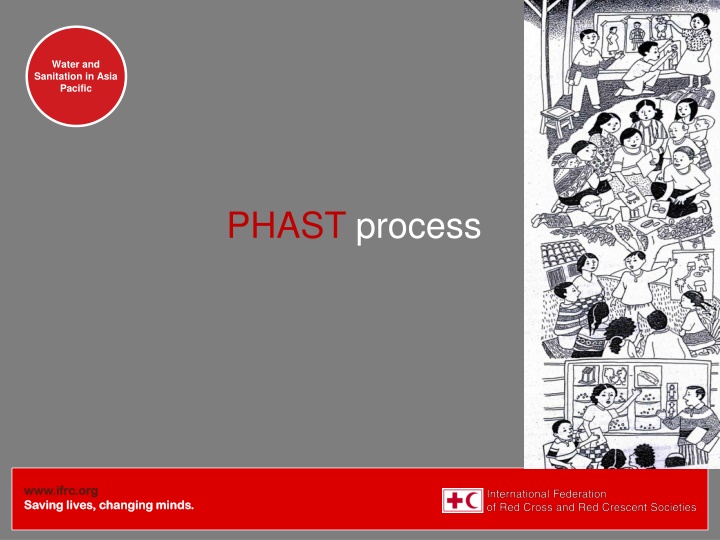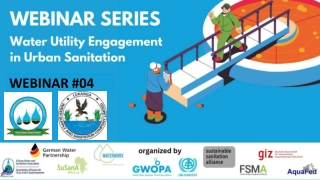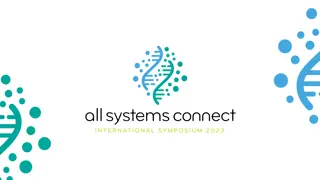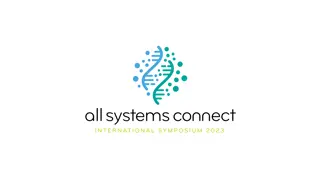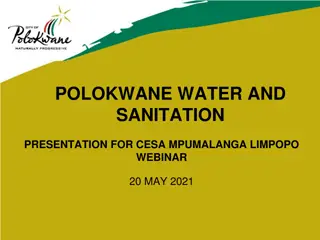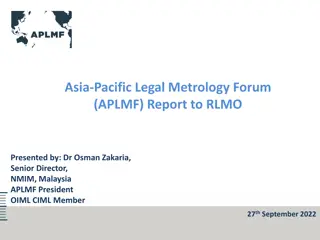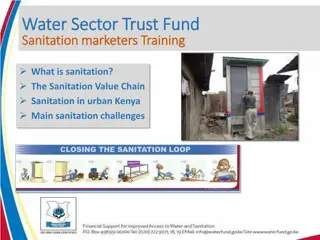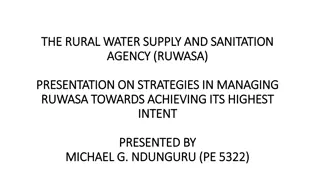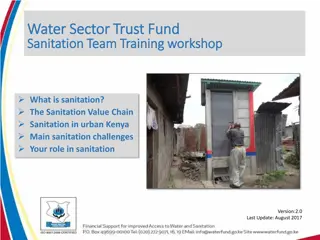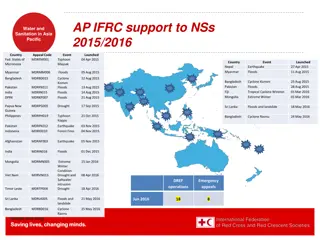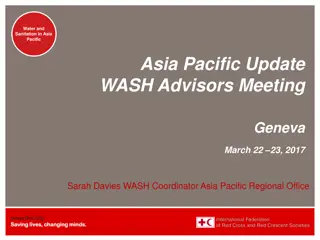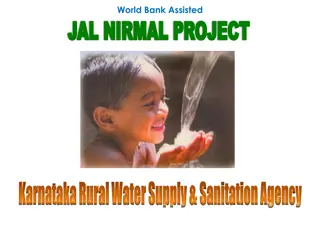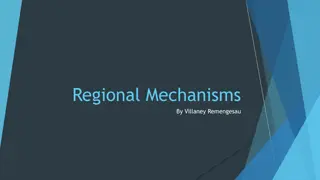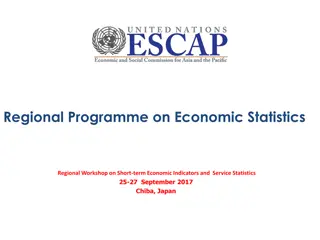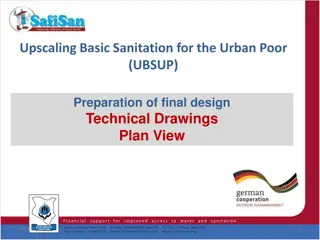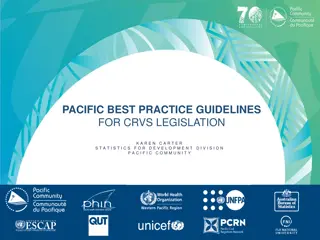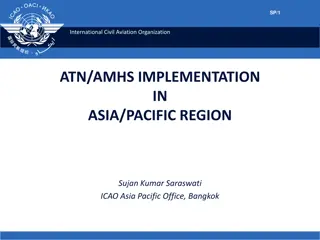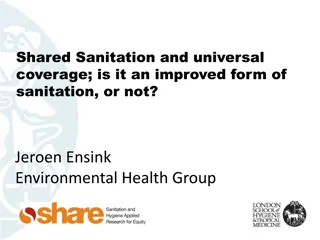Water and Sanitation in Asia Pacific: Community Planning for Health Improvement
The article discusses the PHAST process (Participatory Hygiene and Sanitation Transformation) in Asia Pacific, focusing on seven steps for community planning to prevent diarrhoeal diseases. It covers problem identification, analysis, planning for solutions, selecting options, monitoring, evaluation, and participatory evaluation. Tools and activities such as community stories, health problem identification, and problem analysis are emphasized to address water and sanitation issues effectively in the region.
Download Presentation

Please find below an Image/Link to download the presentation.
The content on the website is provided AS IS for your information and personal use only. It may not be sold, licensed, or shared on other websites without obtaining consent from the author.If you encounter any issues during the download, it is possible that the publisher has removed the file from their server.
You are allowed to download the files provided on this website for personal or commercial use, subject to the condition that they are used lawfully. All files are the property of their respective owners.
The content on the website is provided AS IS for your information and personal use only. It may not be sold, licensed, or shared on other websites without obtaining consent from the author.
E N D
Presentation Transcript
Water and Sanitation in Asia Pacific PHAST process www.ifrc.org www.ifrc.org Saving lives, changing minds. Saving lives, changing minds.
Water and Sanitation in Asia Pacific Seven steps to community planning for the prevention of diarrhoeal disease Step 1 Problem identification Step 2 Problem analysis Step 3 Planning for solutions Step 4 Selecting options Planning for new facilities and behaviour change Step 5 Step 6 Planning for monitoring and evaluation Step 7 Paticipatory evaluation www.ifrc.org www.ifrc.org Saving lives, changing minds. Saving lives, changing minds.
Water and Sanitation in Asia Pacific The PHAST Process Step Activity Tool A STEP may contain one or more activities aimed at achieving one overall objective. An ACTIVITY is what the group works through to discover the information and skills necessary to reach an understanding or take an action. TOOLS are the techniques and materials the facilitator uses to help the group work through an activity. www.ifrc.org www.ifrc.org Saving lives, changing minds. Saving lives, changing minds.
Step 1. Problem identification Water and Sanitation in Asia Pacific STEP 1: PROBLEM IDENTIFICATION Activity Tool Step 1 1. Community stories 1. Unserialised posters Problem identification 2. Health problems in our community 2. Nurse Tanaka In this step there are two activities ACTIVITY 1: COMMUNITY STORIES The objective of activity is; To enable the group members to identify important issues and problems facing their community To help build a feeling of team spirit and mutual understanding To generate group self esteem and creativity UNSERIALISED POSTERS TOOL www.ifrc.org www.ifrc.org Saving lives, changing minds. Saving lives, changing minds.
Water and Sanitation in Asia Pacific Step 1. Problem identification ACTVITY 2: HEALTH PROBLEMS IN OUR COMMUNITY The activity is designed to help identify important health problems in the community and to discover which ones can be prevented by community action. NURSE TANAKA TOOL www.ifrc.org www.ifrc.org Saving lives, changing minds. Saving lives, changing minds.
Step 2. Problem analysis STEP 2: PROBLEM ANALYSIS Water and Sanitation in Asia Pacific Tool Activity 1. Community mapping Step 2 1. Mapping water and sanitation in our community 2. Three pile sorting 2. Good and bad hygiene behaviors Problem analysis 3. Pocket chart 3. Investigating community practices 4. Transmission routes 4. How diseases spread ACTIVITY 1: MAPPING WATER AND SANITATION IN OUR COMMUNITY This assists the participants to map those water and sanitation problems which could lead to diarrhoeal diseases. COMMUNITY MAP TOOL www.ifrc.org www.ifrc.org Saving lives, changing minds. Saving lives, changing minds.
Step 2. Problem analysis Water and Sanitation in Asia Pacific ACTIVITY 1. MAPPING WATER AND SANITATION IN OUR COMMUNITY A community mapping exercise helps the community to identify critical problems and possible interventions, including toilets, grey water and solid waste management. Transect walk www.ifrc.org www.ifrc.org Saving lives, changing minds. Saving lives, changing minds.
Step 2. Problem analysis Pacific ACTIVITY 2: GOOD AND BAD HYGIENE BEHAVIOURS Water and Sanitation in Asia The activity helps the group to look more closely at common hygiene and sanitation practices and to identify how these may be good or bad for health. 3 PILE SORTING TOOL www.ifrc.org www.ifrc.org Saving lives, changing minds. Saving lives, changing minds.
Step 2. Problem analysis ACTIVITY 3: INVESTIGATING COMMUNITY PRACTICES Water and Sanitation in Asia Pacific The purpose of the activity is to help the group collect and analyze data on actual water ,sanitation and hygiene practices in the community. POCKET CHART TOOL www.ifrc.org www.ifrc.org Saving lives, changing minds. Saving lives, changing minds.
Step 2. Problem analysis Water and Sanitation in Asia Pacific ACTIVITY 4: HOW DISEASES SPREAD The purpose is help the participants discover and analyze how diarrheal can be spread through the environment and the tool used is faucal oral transmission routes. This tool is normally used to look at how faeces can contaminate the environment and lead to diarrhoeal. TRANSMISSION ROUTES TOOL www.ifrc.org www.ifrc.org Saving lives, changing minds. Saving lives, changing minds.
PHAST STEP 3:PLANNING FOR SOLUTIONS Step 3. Planning for Solutions Water and Sanitation in Asia Pacific Activity Tool Step 3 1. Blocking the spread of disease 1. Blocking the routes Planning for solutions 2. Selecting the barriers 2. Barriers chart 3. Task of men and women and women in the community 3. Gender role analysis Activity 1: Blocking The Spread Of Diseases Blocking the spread of diseases helps the participants to discover ways to prevent diarrhea diseases from being spread via the transmission routes identified in the previous activity. Faucal Oral route barrier tool www.ifrc.org www.ifrc.org Saving lives, changing minds. Saving lives, changing minds.
Step 2. Problem analysis Water and Sanitation in Asia Pacific ACTIVITY 4: HOW DISEASES SPREAD Open discussion on hygiene and sanitation issues among school children and Community www.ifrc.org www.ifrc.org Saving lives, changing minds. Saving lives, changing minds.
The F Diagram Water and Sanitation in Asia Pacific Different transmission routes whereby pathogens can get from the faeces of an infected person through fluids, (mainly drinking water), fields (soil), fingers and food. Nine barriers/facilities associated with hygiene practices: 1. and 2. Pit latrines and Ventilated Improved Pit (VIP) latrines 3. Protection of water sources 4. Protection of food, safe waste reuse 5. Handwashing at critical times 6. Protection of food, storage www.ifrc.org www.ifrc.org Saving lives, changing minds. Saving lives, changing minds. 7. Protection of food, handling and preparation 8. Protection of water in transit and in the home 9. Safe eating, washing raw foods before eating them (SourceHygiene Evaluation Procedures: Approaches and Methods for Assessing Water and Sanitation Related Hygiene Practices. Astier M. Almedom, Ursula Blumenthal, andLenoreManderson, INFDC, 1997)
Step 3. Planning for Solutions Water and Sanitation in Asia Pacific Activity 2: Selecting The Barriers This activity helps the group to analyze the effectiveness and ease of actions to block transmission routes and choose which they want to carry out themselves. www.ifrc.org www.ifrc.org Saving lives, changing minds. Saving lives, changing minds.
Step 3. Planning for Solutions Barrier chart Water and Sanitation in Asia Pacific Easy to do In between Hard to do Effective 1 In between Not effective www.ifrc.org www.ifrc.org Saving lives, changing minds. Saving lives, changing minds.
Water and Sanitation in Asia Pacific Question Can you list critical time for Hand washing? www.ifrc.org www.ifrc.org Saving lives, changing minds. Saving lives, changing minds.
Hand washing at critical times Water and Sanitation in Asia Pacific Before eating Before handling food /water Before feeding baby After defecation Before breast feeding After handling baby s faeces www.ifrc.org www.ifrc.org Saving lives, changing minds. Saving lives, changing minds.
Activity 3: Tasks for Men and Women Water and Sanitation in Asia Pacific The activity identifies which are the roles undertaken by men, women and children and who would be able to take additional tasks to introduce changes necessary to prevent diarrheal diseases. The purpose of this tool is to: Raise awareness and understanding of which household and community tasks are done by women and which are done by men To identify whether any change in task allocation would be desirable and possible GENDER TASK ANALYSIS /24 HOUR CALENDAR TOOL www.ifrc.org www.ifrc.org Saving lives, changing minds. Saving lives, changing minds.
Gender Sensitive Programming Water and Sanitation in Asia Pacific Gender is the culturally defined division of work and areas of responsibility,authority and cooperation between men and women . For every improvement related to health and hygiene one must therefore ask if it concerns men, women or both and whether either category has specific needs, priorities and resources. Communication channels and messages must be developed for both men and women. www.ifrc.org www.ifrc.org Saving lives, changing minds. Saving lives, changing minds.
